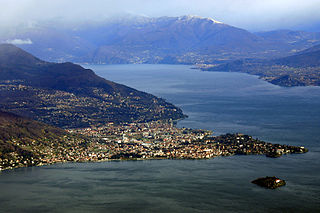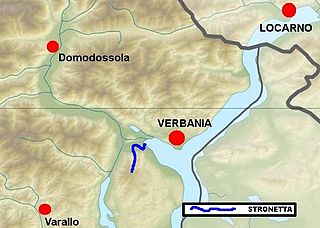The Fondo Toce or Fondotoce (Italian pronunciation: [ˌfondoˈtoːtʃe] ) Natural Reserve is a nature reserve established in 1990 in the Verbania municipality, which takes its name from the river Toce. [1]

A nature reserve is a protected area of importance for flora, fauna or features of geological or other special interest, which is reserved and managed for conservation and to provide special opportunities for study or research. Nature reserves may be designated by government institutions in some countries, or by private landowners, such as charities and research institutions, regardless of nationality. Nature reserves fall into different IUCN categories depending on the level of protection afforded by local laws. Normally it is more strictly protected than a nature park.

Verbania is the most populous comune (municipality) and the capital city of the province of Verbano-Cusio-Ossola in the Piedmont region of northwest Italy. It is situated on the shore of Lake Maggiore, about 91 km (57 mi) north-west of Milan and about 40 km (25 mi) from Locarno in Switzerland. It had a population of 30,827 at 1 January 2017.

The Toce is a river in Piedmont, Italy, which stretches the length of the Val d'Ossola from the Swiss border to Lake Maggiore into which it debouches near Fondotoce in the commune of Verbania. The river is 83.6 kilometres (51.9 mi) long and is formed in the upper Val Formazza by the confluence of a number of torrents in the plain of Riale.
Contents
The area includes the Toce connection with Lake Maggiore, characterised by the widest lake's rushes, very important for the reproduction of fishes and migratory birds. The Great cormorants sleep here by the river and swallows stop here during migrations.

Lake Maggiore or Lago Verbàno is a large lake located on the south side of the Alps. It is the second largest lake in Italy and the largest in southern Switzerland. The lake and its shoreline are divided between the Italian regions of Piedmont and Lombardy and the Swiss canton of Ticino. Located halfway between Lake Orta and Lake Lugano, Lake Maggiore extends for about 65 kilometres between Locarno and Arona.

Fish are gill-bearing aquatic craniate animals that lack limbs with digits. They form a sister group to the tunicates, together forming the olfactores. Included in this definition are the living hagfish, lampreys, and cartilaginous and bony fish as well as various extinct related groups. Tetrapods emerged within lobe-finned fishes, so cladistically they are fish as well. However, traditionally fish are rendered paraphyletic by excluding the tetrapods. Because in this manner the term "fish" is defined negatively as a paraphyletic group, it is not considered a formal taxonomic grouping in systematic biology, unless it is used in the cladistic sense, including tetrapods. The traditional term pisces is considered a typological, but not a phylogenetic classification.

Birds, also known as Aves, are a group of endothermic vertebrates, characterised by feathers, toothless beaked jaws, the laying of hard-shelled eggs, a high metabolic rate, a four-chambered heart, and a strong yet lightweight skeleton. Birds live worldwide and range in size from the 5 cm (2 in) bee hummingbird to the 2.75 m (9 ft) ostrich. They rank as the world's most numerically-successful class of tetrapods, with approximately ten thousand living species, more than half of these being passerines, sometimes known as perching birds. Birds have wings which are more or less developed depending on the species; the only known groups without wings are the extinct moa and elephant birds. Wings, which evolved from forelimbs, gave birds the ability to fly, although further evolution has led to the loss of flight in flightless birds, including ratites, penguins, and diverse endemic island species of birds. The digestive and respiratory systems of birds are also uniquely adapted for flight. Some bird species of aquatic environments, particularly seabirds and some waterbirds, have further evolved for swimming.
There are rare and native vegetals, like the water caltrop (Trapa natans verbanensis).

The water caltrop is any of three extant species of the genus Trapa: Trapa natans, Trapa bicornis and the endangered Trapa rossica. It is also known as buffalo nut, bat nut, devil pod, ling nut, lin kok, ling kio nut, mustache nut or singhada.













